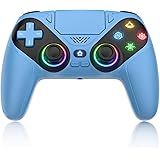When seeking the ultimate gaming audio experience, the conventional wisdom often points directly to purpose-built gaming headsets. However, as highlighted in the accompanying video featuring Alex from rtings.com, it is worth considering an alternative path: audiophile headphones for gaming. Many of these options deliver superior sound quality and an immersive edge that dedicated gaming peripherals sometimes overlook in favor of aesthetics and marketing.
Indeed, the world of gaming peripherals is often rife with buzzwords and flashy features. While RGB lighting and aggressive designs are appealing, they do not always translate to a tangible performance advantage. Instead, a focus on core audio performance can profoundly elevate your gameplay, allowing you to discern subtle sound cues or fully immerse yourself in rich game worlds. This guide will explore the benefits and practical considerations of integrating audiophile-grade headphones into your gaming setup, expanding upon the insights shared in the video.
Beyond the Hype: Why Consider Audiophile Headphones for Gaming?
Traditional gaming headsets frequently bundle a microphone, wireless connectivity, and proprietary software into a single package. These features offer undeniable convenience. Nevertheless, they can come at the cost of pure audio fidelity. Audiophile headphones, by contrast, prioritize sound reproduction above all else, often employing higher-quality drivers and more refined acoustic designs. Consequently, they deliver a more accurate, detailed, and expansive sound. This can be critical for both competitive play and deep immersion.
Imagine if every distant footstep in a first-person shooter became distinct, or if the intricate musical score of an open-world RPG enveloped you completely. Such clarity and spatial accuracy are the hallmarks of quality audio engineering, which audiophile headphones consistently offer. Furthermore, the robust build quality and timeless design of many audiophile options often provide greater longevity than their more consumer-focused gaming counterparts.
Key Considerations for Integrating Audiophile Gear
Transitioning from a typical gaming headset to an audiophile setup involves a few key decisions. These factors ultimately determine the compatibility and overall convenience of your new audio solution.
Wired vs. Wireless Connectivity
The vast majority of audiophile headphones are wired. This design choice bypasses the potential for signal latency, interference, and battery limitations inherent in wireless connections. A wired connection guarantees near-universal compatibility across PCs and consoles, ensuring a consistent and high-fidelity audio signal.
However, opting for wired headphones means contending with cables. For some, this is a minor inconvenience, easily managed with cable clips or tidies. For others, the freedom of wireless gaming is paramount. Console gamers must also consider the audio source. Unless you invest in an external amp/DAC (Digital-to-Analog Converter) or split the audio from your HDMI signal, your controller’s 3.5mm jack will typically be the source. This means high impedance headphones, which demand more power, may not reach sufficient volume levels, and you will be relying on the controller’s internal audio hardware, which is usually adequate for most users but not always ideal for true audiophile performance.
Microphone Integration
Modern gaming is inherently social, requiring clear communication with teammates. Most audiophile headphones do not come with an integrated microphone. Nevertheless, this issue is easily circumvented with several excellent aftermarket solutions.
For combined audio and mic jacks (common on console controllers and some laptops), a ModMic or a dedicated aftermarket cable with an inline microphone provides a simple plug-and-play solution. For PC gamers, the options expand significantly. A dedicated USB or XLR microphone offers unparalleled vocal clarity, allowing you to communicate with precision, whether you’re strategizing call-outs or simply chatting with friends. This modular approach also means you can upgrade your microphone independently of your headphones, optimizing each component for its specific task.
Convenience, Customization, and Versatility
While wireless gaming headsets often provide software for EQ adjustments and presets, many audiophile headphones can achieve similar, if not superior, customization. On Windows PCs, free software such as Equalizer APO allows for precise sound signature adjustments to any headphone. This empowers users to tailor the sound profile to specific game genres or personal preferences, whether emphasizing footsteps in competitive shooters or boosting bass for cinematic immersion.
Moreover, audiophile headphones excel in versatility. While gaming headsets can sometimes double as casual listening gear, audiophile options are inherently designed for critical listening. Imagine seamlessly transitioning from pinpointing enemies in a tactical shooter to appreciating the subtle nuances of your favorite music tracks. This dual functionality offers exceptional value, transforming your audio gear into a multifaceted tool for both entertainment and analysis.
Top Audiophile Headphone Recommendations for Gaming
Having clarified the foundational concepts, let us delve into specific recommendations that deliver excellent audio performance for gaming. As the video from rtings.com attests, significant testing reveals impressive options across various price points.
Budget-Friendly Open-Back Headphones
Open-back headphones are a popular choice among audiophiles and gamers alike, known for their spacious soundstage and natural sound reproduction. This design allows air to pass through the earcups, creating a more “open” sound often associated with a wider perceived sound field. However, this also means they offer poor noise isolation and leak sound, making them best suited for quiet environments.
- Superlux HD 681: These headphones are an excellent entry point for under $50. They boast solid imaging performance, enabling accurate rendering of spatial cues like footsteps. While their bright frequency response might be polarizing, perceived as either detailed or harsh, they offer incredible value. Despite some concessions in durability due to their price point, their comfort is commendable. The slightly more expensive Superlux HD 681 EVO offers improved build quality, but the audio improvements may not justify the additional cost for all users.
- Philips SHP9500 / SHP9600: Stepping up slightly in price, both Philips models feature a sturdier build with metal components and a padded headband for enhanced comfort. These open-back headphones also offer solid imaging performance, meaning cinematic sound effects are clearly distinguishable in the stereo image. The SHP9500 is often preferred due to the SHP9600’s bass emphasis, which can sometimes muddy dialogue in busy scenes. Neither model excels in sub-bass reproduction, so do not expect rumbling explosions.
In-Ear Monitors (IEMs) for Gaming
While open-back headphones are widely recognized for their soundstage, in-ear monitors (IEMs) present a compelling alternative, especially in the budget category. They offer stronger bass and superior passive noise isolation, making them viable even in competitive gaming where audio cues are critical. The video highlights that many top-tier esports pros utilize IEMs, demonstrating their effectiveness. They excel in delivering impactful bass rumble, crucial for immersion in action-packed games.
- Truthear x Crinacle Zero Blue and Red: Both versions are comfortable, well-built, and stable. They show no significant issues in imaging metrics, ensuring easy detection of spatial cues. The Blue has a V-shaped sound with a sub-bass taper, while the Red offers a more balanced profile. The Red also includes a 10-ohm adapter to enhance low-end thump while maintaining its high-bass taper, delivering solid bass reproduction ideal for realistic in-game explosions.
- Truthear Hexa: From the same brand, the Hexa offers a slightly more balanced sound than the Crinacle collabs. While some may find this tuning less “fun” than V-shaped options, its balanced profile works exceptionally well for both casual listening and precise gaming. It performs excellently in stereo matching tests, making it a worthwhile upgrade for those seeking accuracy.
Mid-Range Over-Ear Options
For gamers with a larger budget, the mid-range introduces a variety of over-ear headphones that excel in gaming scenarios.
- Beyerdynamic DT 990 PRO: This open-back model is highly respected in the gaming community. It features solid stereo driver matching, clean group delay performance, and outstanding harmonic distortion results. This clarity means critical sound cues, such as footsteps in games like Escape from Tarkov, come through distinctly. The 80-ohm variant is generally recommended, as it achieves sufficient loudness even when connected directly to console controllers like the PS5 or Xbox. Be aware of the classic Beyerdynamic treble peak around 9 kHz, which some listeners might find fatiguing. The newer DT 990 PRO X (48-ohm) reportedly tames this treble while retaining similar characteristics.
- Sennheiser HD 560S: These 120-ohm open-back headphones offer a flat sound profile, prioritizing precision over pure immersion. They provide an accurate representation of positional cues, making them excellent for competitive shooters. However, their high impedance means they are harder to drive and may require an external amp or DAC for optimal performance, especially with consoles. While some units have shown imaging issues due to mismatched drivers, quality control varies.
- Sennheiser HD 490 PRO: A standout for comfort, these headphones rank among the comfiest tested, particularly with their “producing” earpads. They deliver strong imaging performance in stereo matching and group delay, allowing users to pinpoint enemy locations effortlessly. Furthermore, their solid bass extension and pronounced high-bass make them excellent for cinematic-style games, enhancing immersion in narrative-driven experiences.
Undoubtedly, selecting the ideal audiophile headphones for gaming requires careful consideration of individual needs, budget, and setup. The options discussed, from the ultra-affordable Superlux HD 681 to the highly comfortable Sennheiser HD 490 PRO, represent some of the finest choices available. Ultimately, investing in quality audiophile headphones for gaming provides a clear pathway to a more detailed, immersive, and competitive audio experience.









